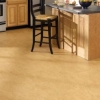
What Type of Flooring Should You Choose for Your New Home?
By Budget Trucks|June 22, 2016
Choosing the flooring for your new home is a very big aspect of the design aesthetic. There are many things to consider when it comes to flooring and it comes down to style, lifestyle and budget. There are more choices now than ever before which can make the process of choosing a little more complicated. The best way to figure out your flooring is to educate yourself about each type of flooring. New flooring styles are being created and modified all the time, so even if you researched floor types a year or two ago, it’s time to brush up on what’s new in flooring styles. When it comes to flooring, you might already have a preference and you might base your flooring on each individual room. The flooring choices break down into eight categories: rug, wood, wood laminate, tile, linoleum, concrete, cork and vinyl.
Kitchens and Bathroom Flooring Ideas

Cork Flooring Example Photo Credit: DIYNetwork.com
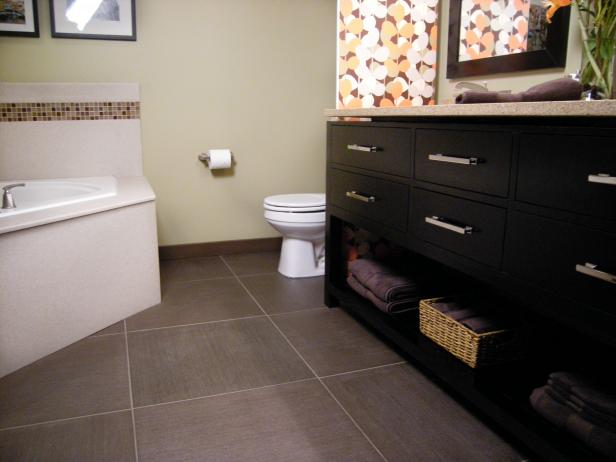
Tile Flooring Photo Credit: DIYNetwork.com
Rooms like bathrooms and kitchens must have a flooring that can stand up to water. Tile is usually the choice of preference since it can hold up to water. Popular choices for kitchens that are easy to clean and durable include linoleum, ceramic tile, and wood. Cork is a new trend in kitchen flooring alternatives. It gives the floor a softer feel under your feet, is great at absorbing sound vibrations and will bounce back if dented. Cork is also non slip type of flooring and have a very natural look. Linoleum used to be a popular flooring in the 1960’s and 1970’s but is making a comeback. It’s new appeal is largely based on the fact that it is very eco-friendly and hypoallergenic. It is made from natural materials but does not deplete the forests. It is mostly comprised of linseed oil, rosins, and wood flour. Because it has bactericidal properties, it stops microorganisms from multiplying and spreading. It is waterproof and very sturdy; plus linoleum is available in a wide variety of colours and patterns. Bathrooms need a flooring that can stand up to moisture and popular bathroom flooring choices include linoleum, ceramic tile, limestone, marble, or granite. If you choose to go with tile, then you have a whole host of possibilities within that type of flooring. Porcelain tile is the most budget-friendly type of flooring. It is beautiful and durable which helps add to its appeal. Other popular tile materials include terra cotta, natural stone, marble, granite, travertine, or slate. All tile is durable and can get wet and be easily cleaned. Beware of products like marble that look beautiful but are porous and will need to be resealed periodically.
Living Space Flooring Options
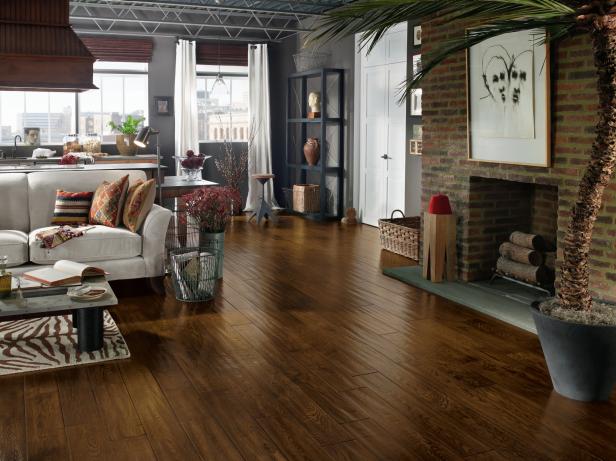
Wood Flooring example Photo Credit: HGTV.com
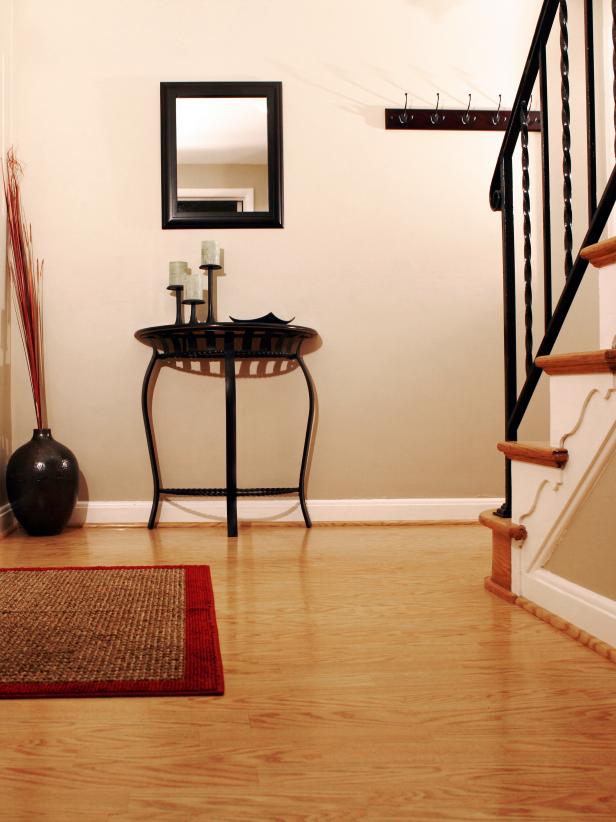
Wood Laminate Flooring Example Photo Credit: DIYNetwork.com
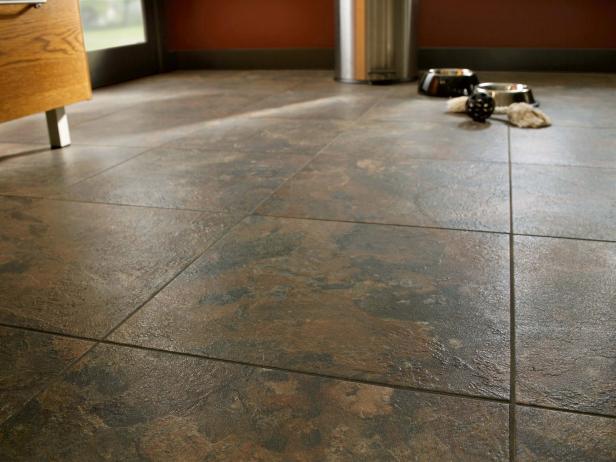
Vinyl Flooring Example Photo Credit: DIYNetwork.com
When it comes to your living space, it’s a matter of taste and there is no shortage of choices with different tiles, carpeting, or wood. Another factor that you might consider is how easy it is to install; this is especially the case if you are installing the flooring yourself. Vinyl is a newer product that is very durable, waterproof and installs in easy and usually is made in self-stick tiles that have a glue backing. It can look like tile or wood which makes it an option for any room. Vinyl is waterproof and some newer styles of wood laminate are also waterproof. The thicker a vinyl is, the more traffic it can endure. The look of wood can be achieved with wood or wood laminate and is a very popular flooring choice. Wood colours are available from very light, even washed out wood to very dark stained look flooring. You can learn how to install wood laminate or wood because most brands lock in and fit together. Installing tile takes a bit more skill and practice since it involves grout and the tools to cut the tiles to fit the room properly. The last consideration is budget. There are different price points for each style of flooring. Don’t forget to include the costs for backings, padding, baseboards, molding, and other materials you will need to complete the floor and have a finished look. You should consult with a flooring expert or general contractor especially if you have an older home because a subfloor might be a good idea.
Kitchens and Bathroom Flooring Ideas

Cork Flooring Example Photo Credit: DIYNetwork.com

Tile Flooring Photo Credit: DIYNetwork.com
Rooms like bathrooms and kitchens must have a flooring that can stand up to water. Tile is usually the choice of preference since it can hold up to water. Popular choices for kitchens that are easy to clean and durable include linoleum, ceramic tile, and wood. Cork is a new trend in kitchen flooring alternatives. It gives the floor a softer feel under your feet, is great at absorbing sound vibrations and will bounce back if dented. Cork is also non slip type of flooring and have a very natural look. Linoleum used to be a popular flooring in the 1960’s and 1970’s but is making a comeback. It’s new appeal is largely based on the fact that it is very eco-friendly and hypoallergenic. It is made from natural materials but does not deplete the forests. It is mostly comprised of linseed oil, rosins, and wood flour. Because it has bactericidal properties, it stops microorganisms from multiplying and spreading. It is waterproof and very sturdy; plus linoleum is available in a wide variety of colours and patterns. Bathrooms need a flooring that can stand up to moisture and popular bathroom flooring choices include linoleum, ceramic tile, limestone, marble, or granite. If you choose to go with tile, then you have a whole host of possibilities within that type of flooring. Porcelain tile is the most budget-friendly type of flooring. It is beautiful and durable which helps add to its appeal. Other popular tile materials include terra cotta, natural stone, marble, granite, travertine, or slate. All tile is durable and can get wet and be easily cleaned. Beware of products like marble that look beautiful but are porous and will need to be resealed periodically.
Living Space Flooring Options

Wood Flooring example Photo Credit: HGTV.com

Wood Laminate Flooring Example Photo Credit: DIYNetwork.com

Vinyl Flooring Example Photo Credit: DIYNetwork.com
When it comes to your living space, it’s a matter of taste and there is no shortage of choices with different tiles, carpeting, or wood. Another factor that you might consider is how easy it is to install; this is especially the case if you are installing the flooring yourself. Vinyl is a newer product that is very durable, waterproof and installs in easy and usually is made in self-stick tiles that have a glue backing. It can look like tile or wood which makes it an option for any room. Vinyl is waterproof and some newer styles of wood laminate are also waterproof. The thicker a vinyl is, the more traffic it can endure. The look of wood can be achieved with wood or wood laminate and is a very popular flooring choice. Wood colours are available from very light, even washed out wood to very dark stained look flooring. You can learn how to install wood laminate or wood because most brands lock in and fit together. Installing tile takes a bit more skill and practice since it involves grout and the tools to cut the tiles to fit the room properly. The last consideration is budget. There are different price points for each style of flooring. Don’t forget to include the costs for backings, padding, baseboards, molding, and other materials you will need to complete the floor and have a finished look. You should consult with a flooring expert or general contractor especially if you have an older home because a subfloor might be a good idea.



